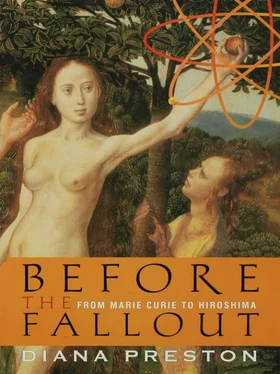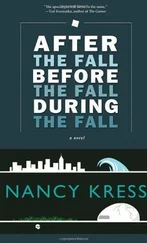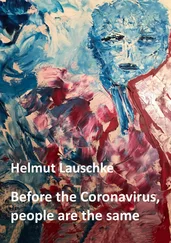
Ernest Rutherford
Nineteen hundred was also the year that Rutherford made the first in a chain of discoveries that would challenge the accepted laws of chemistry and establish his reputation. While investigating the properties of the heavy element thorium, he identified a mysterious discharge, or “emanation,” whose radioactivity reduced “in a geometrical progression with time.” In this case it declined to half its original value in sixty seconds and by half of that half-value in the next sixty seconds, so that after two minutes only a quarter of the original activity remained and after three minutes only one eighth. By inspired but careful experimentation he had uncovered a phenomenon at the very core of radioactivity: the half-life.
The timely arrival at McGill of the English chemist Frederick Soddy gave Rutherford a partner to help analyze the chemical significance of his findings. Initially the two young men sparred. At a meeting of the Physical Society chaired by Rutherford, the subject for debate was “the existence of bodies smaller than an atom.” Soddy’s paper “Chemical Evidence of the Indivisibility of the Atom” lambasted physicists like J. J. Thomson for unjustifiably attacking classical atomic theory. Soddy’s passion surprised Rutherford but, impressed by the Englishman’s intellect, he invited him to collaborate on examining the mysterious thorium emanation. Soddy agreed, recognizing Rutherford as “an indefatigable investigator guided by an unerring instinct for the relevant and important.”
They began work in October 1901 and soon proved that the emanation was not merely the result of some disturbance of the air caused by the radioactivity in thorium. The emanation was an inert gas—one without active chemical properties—which would not react or combine with anything. The evidence suggested it was another element, and this moment of discovery was awesome. Soddy, “standing there transfixed as though stunned by the colossal import of the thing,” turned to his companion and said: “Rutherford, this is transmutation: the thorium is disintegrating and transmuting itself into an argon gas.” Rutherford “shouted to me, in his breezy manner, ‘For Mike’s sake, Soddy, don’t call it transmutation. They’ll have our heads off as alchemists. You know what they are.’ After which he went waltzing round the laboratory, his huge voice booming, ‘Onward Christian so-ho-hojers [soldiers]’ which was more recognizable by the words than by the tune.” Rutherford urged Soddy to call their discovery not transmutation but transformation. They checked and rechecked, but their results held good. Their discovery, which was indeed akin to alchemy, suggested that radioactive elements disintegrate spontaneously and unstoppably, forming different “daughter” elements in the process. They contain unstable atoms which decay over time, shedding radiation in the form of alpha or beta particles in an attempt to reach stability.
However logical it might have seemed in the laboratory, Rutherford and Soddy knew that their “disintegration theory” contradicted another basic law: the immutability and indestructibility of chemical elements. As they expected, their work provoked skepticism and hostility. Alarmed colleagues warned they would bring discredit on McGill University and urged them to delay publishing their findings. The British chemist Henry Edward Armstrong demanded to know why atoms should indulge in an “incurable suicide mania.” But Rutherford and Soddy refused to be browbeaten, facing down their opponents with confidence and hard evidence.
They were helped by J. J. Thomson in England, who steered them through these potentially damaging and difficult times, ensuring early publication of their papers and lending his authority to their findings. By 1903 they had published a series of papers they considered conclusive. The final paragraph of their final paper stated, “All these considerations point to the conclusion that the energy latent in the atom must be enormous.” Around this time Rutherford made a “playful suggestion” that if a proper detonator could be found, it was conceivable that “a wave of atomic disintegration might be started through matter, which would indeed make this old world vanish in smoke.”
The Curies were among the skeptics. In the generous, collaborative spirit of the time, they had loaned Rutherford a sufficiently powerful radioactive source to allow him to conduct his research, and they were keenly interested in the findings. As early as 1900 Marie Curie had written that the idea of some kind of transformation was very seductive and explained the phenomena of radioactivity very well, but despite her belief that radioactivity was an atomic phenomenon, she had shied away. Transformation seemed too revolutionary, too alien to the laws of chemistry. The Curies wondered whether Rutherford and Soddy were rushing to unjustified conclusions based too narrowly on findings from thorium. They also worried that the transmutation theory threatened the status of their discoveries, radium and polonium, by redefining them as transitional entities rather than new elements.
In fact, as the theory developed, the reverse would prove true. The theory would explain where radium and polonium fitted in despite their instability. Uranium slowly but inexorably decays, transmuting through a series of radioactive elements, all present in uranium ores. The chain ends when uranium finally transforms into stable, unradioactive lead. Radium is the fifth element in the chain descending from uranium to lead, and polonium is the penultimate link in the chain before lead. The fact that uranium is still present in the Earth’s crust—created some 4.5 billion years ago—shows just how slowly uranium decays.
The Curies’ perplexity was heightened by Pierre’s discovery in 1903 that radium released an astonishing amount of heat. Just 1 gram of radium could heat around 1.3 grams of water from freezing point (0°C) to boiling (100°C) in an hour. These seemingly bizarre findings contradicted the nineteenth-century law of conservation of energy, which stated that although energy might change from one form to another (for example, from heat to motion), it could not be conjured out of nowhere. The Curies speculated whether some sort of external energy might be responsible. Others wondered whether gravitational energy might have something to do with it. Nevertheless, the Curies were uncomfortably aware that the transformation theory offered an explanation—that the energy was being conjured from within the atom. Eventually, they would come to accept it.
Rutherford’s knowledge of the Curies’ work had made him eager to meet them. In 1903 the opportunity came. While visiting England from McGill to defend his heretical transformation theory, Rutherford, accompanied by Mary, took a trip to the Continent. Reaching Paris on a hot June day, he was alerted by a postcard from Soddy that Marie Curie wished him to call. He hastened to her ramshackle workplace to find it locked. It was, in fact, the very day she was being examined on her triumphal doctoral thesis, “Researches on Radioactive Substances,” reporting her work on isolating radium. However, he managed to track down Paul Langevin, whom he had met during his Cavendish days, and Langevin invited the Rutherfords to the celebration that night, at which Pierre Curie brandished his tube of glowing radium in his damaged hands.
It was, by all accounts, a lively evening, unmarred by any differences of opinion. Rutherford admired Marie Curie’s intellect, “no-nonsense” style, and directness. She, in turn, appreciated that he treated her as an equal. This was to be the first of many meetings between them, but, sadly, it was the one and only time he would talk with Pierre Curie. Just three years later on a wet, windy, overcast Paris afternoon, Pierre absentmindedly stepped out in front of a horse-drawn wagon in the Rue Dauphine. Too late he tried to scramble out of the way, slipped, and fell. The wagon’s iron-rimmed rear left wheel crushed his skull, spilling his brains on the wet boulevard. He was only forty-six.
Читать дальше













